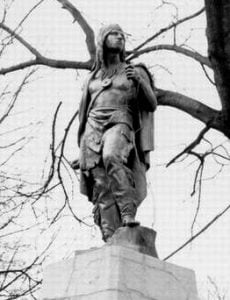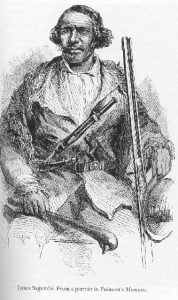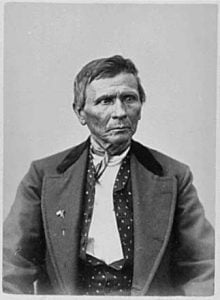In 1682, the seat of the Delaware government was at Shackamaxon, now Germantown, Pennsylvania. There Penn found them and made his famous treaty with them. Although extremely warlike, they had surrendered their sovereignty to the Iroquois about 1720. They were pledged to make no war, and they were forbidden to sell land. All the causes of this step were not known. Because of it the Iroquois claimed to have made women of the Delaware. They freed themselves of this opprobrium in the French and Indian War.

The steady increase of the whites drove the Delaware from their ancient seat. They were crowded off the waters of the Delaware, and settled on the Susquehanna. As early as 1742 they were to be found about Wyoming. It was soon impossible for them to remain there, and they went back of the mountains to the head waters of the Allegheny. They slowly spread down this stream, living for some time on the Beaver. At that time the Wyandot were holding the western country for their kindred, the Iroquois. Seeing the Delaware hard pressed, the Wyandot tendered them a home, and suggested that they seat themselves on the Tuscarawas River, an upper branch of the Muskingum. They were later visited by the Moravians, who established missions among them, chiefly those living on the Tuscarawas. These missions were in a flourishing condition when the Revolutionary War came on. That struggle put these Christian Indians in a false position. They wished to remain on their farms and by their churches. The heathen Indians about Upper Sandusky accused them of being in the confidence of the whites of Western Pennsylvania. At the same time the whites accused them of being in league with the heathen Indians. They became an offense to both parties. Divisions in the tribe had already appeared. White Eyes, the great chief, the friend of the Americans, was gradually superseded by Hopocan, or Captain Pipe, as head chief. Pipe was the head of the war faction, in the interest of the British at Detroit. Through his influence the Christian Indians and their teachers were forcibly removed to Upper Sandusky. Returning in the winter to gather their corn, they were set upon by a force from Western Pennsylvania under Captain Williamson. Nearly a hundred were murdered in cold blood after capture and confinement in a cabin. This only provoked more frequent and deadly Indian forays, to stop which, another force was raised in Pennsylvania to invade the Indian country about Upper Sandusky. Colonel William Crawford commanded this expedition, which met with disaster. Crawford was captured, and Captain Pipe burned him at the stake.
The first treaty ever made with an Indian tribe by the United States was concluded with the Delaware at Fort Pitt, September 17, 1778. It was signed by Andrew Lewis, Thomas Lewis, White Eyes, The Pipe, and John Kill Buck. It provided for the formation of an Indian State with a representative in Congress.
The Delaware had part in all the wars against the Western settlers. These wars were terminated by Wayne’s victory. Prior to this the Delaware had commenced to settle on the White River, in Indiana, by permission of the Miami and Piankashaw. They continued their westward migration, crossing the Mississippi on the invitation of the Spanish Government of Louisiana. One Lorimer, who was afterwards commandant of the post at St. Genevieve, induced the Delaware and Shawnees to accept the offer of the Spaniards. There were Delaware about St. Louis before this, however. In 1788 a band of them attacked residences on the outskirts of that town. A Frenchman named Duchouquet was slain at Chouteau’s Pond by a band of Delaware in that year. Here is an incident in the life of the Delaware band at Cape Girardeau:
The Delawares and Shawnees built several villages in the neighborhood of Cape Girardeau; and, after the establishment of the United States government, so sensible were they of the good results of its working, that they determined to fashion a government as near like it as their knowledge and circumstances admitted, and resolved to adopt the habits of civilization. They gave up the chase, buried the tomahawk, and devoted themselves for a little season to the pursuits of agriculture. In their first criminal court, three men were convicted of murder, and without any time for repentance they were taken back of one of the villages, there tomahawked, their bodies burnt upon a pile, and the ashes scattered to the winds.
It is stated in the treaty of November 7, 1825, with the Shawnees, that the Delaware abandoned the Cape Girardeau reservation in 1815. Most of these found their way to Texas by the year 1820. Some of them wandered westward, and settled in Southwest Missouri. On the 3d of October, 1818, those members of the tribe still residing on the White River, in Indiana, made a treaty at St. Mary’s, Ohio, ceding their lands and agreeing to remove west of the Mississippi to a home to be provided for them, but which was not described. Under the terms of this treaty, the remnant of the Delawares settled on a reservation on the James Fork of the White River. This tract embraced parts of the following Missouri counties: Greene, Taney, Christian, Barry, McDonald, Newton, Jasper, and Lawrence. They were followed there by the Peorias and Piankashaw, or portions of these tribes, for in 1828, they had towns on the White River. That of the Piankashaw was just above the present Forsythe, and a village some six miles below contained both Piankashaw and Peorias. The Delaware were not well pleased with the Ozark country, but the old members of the tribe with whom this author has discussed the matter could never give any satisfactory reason as to why they were displeased. Most of them said there was plenty of game, but the country was too hilly. It was perhaps because the Indian loves to roam and move from place to place.
September 24, 1829, there was concluded at Council Camp on the James Fork of White River, between the present towns of Springfield and Ozark, a supplementary article to the St. Mary’s treaty. By the terms of this supplementary article the Delaware gave up their reservation in Missouri. In consideration of this cession they were given a reservation in the fork of the Missouri and Kansas rivers described as follows: The country in the fork of the Kansas and Missouri Rivers, extending up the Kansas River, to the Kansas Line, and up the Missouri River to Camp Leavenworth, and thence by a line drawn Westwardly, leaving a space ten miles wide, north of the Kansas boundary line, for an outlet.
The tribe moved to this reservation immediately, the representatives sent out to make an examination of it endorsing their approval on the treaty on the 19th of October at Council Camp, at the fork of the Kansas and Missouri rivers. In 1830 many of the scattered Delaware arrived, and by 1832, the tribe were almost all on this Kansas River reservation. It was a magnificent tract of land, and many times larger than the tribe required. Their settlements were made in what is now Leavenworth County, and in the western part of Wyandotte County.
In their new home the Delaware came to rely to some extent on the buffalo, to secure which they had been given the outlet north of the Kansa lands. On their excursions into the buffalo country they met the wild tribes of the Plains. These natives resented the appearance in their ancient domain of the newcomers. They made war on the Delaware hunters. In the fall of 1831, two Delaware and their wives were encamped on the buffalo-plains and engaged in hunting. The camp was attacked by the Pawnees, who killed the two men and one of the women. The woman having the child was a little distance from the camp at the time, and she escaped, with her child. There was a straggling camp of Delaware at that time on the Arkansas, in the Creek country. On the 22d of October Rev. Isaac McCoy saw the Delaware woman, who had escaped the Pawnee massacre, at that village. She had carried her child from the upper waters of the Republican, subsisting it and herself on wild grapes and berries. She had been afraid to flee in the direction of her home toward the Missouri, and to escape the Pawnees she had gone in a direction they least expected her to take.
These persecutions the Delaware resolved to put an end to. In 1832 Suwaunock or Capt. Suwaunock, as he signed the supplementary treaty of 1829, assembled the Delaware warriors to make war on the Pawnees for these and other murders. He led his force against the Republican Pawnee villagethe town where Pike had hauled down the Spanish flag and raised the Stars and Stripes. He fell upon the Pawnee town and destroyed it. Some of the Pawnee warriors were away on a buffalo hunt, but if they had been present the result would have been the same. No Indians surpassed the Delaware in courage and warlike spirit. They raided far into Mexico, and one was present at the murder of Dr. Whitman, at the Mission near Walla Walla.
The Delaware and Shawnee warriors were employed by the Government of Mexico to hunt and kill Apaches.
John T. Irving, Junior, saw peace made between the Delaware and the Pawnees. It was at Fort Leavenworth, in the year 1833. The Pawnees claimed all the land between the Platte and Kansas rivers. They regarded the Delaware as trespassers when they went out over their outlet to hunt the buffalo, which was the cause of their war on the Delaware hunters. Irving says the Pawnees had slain many of the Delaware. It was to compose these quarrels that the Indian Commissioner visited the various tribes and summoned them to Fort Leavenworth to meet one another in council and bury the tomahawk. In the councilThe Delaware warrior Sou-wah-nock then rose. He spoke of the destruction of the Grand Pawnee Village. He did not deny his agency in the deed. The Pawnees, said he, met my young men upon the hunt, and slew them. I have had my revenge. Let them look at their town. I found it filled with lodges. I left it a heap of ashes. The whole speech was of the same hold, unflinching character, and was closed in true Indian style. I am satisfied, said he. I am not afraid to avow the deeds I have done, for I am Sou-wah-nock, a Delaware warrior. When he had finished, he presented a string of wampum to the Wild Horse, as being the most distinguished warrior of the Pawnee nation. When the slight bustle of giving and receiving the present had been finished the chief of the Republican village rose to answer his warrior enemy.
His speech abounded with those wild bursts of eloquence which peculiarly mark the natives of North America, and concluded in a manner which spoke highly of his opinion of what a warrior should be. I have promised to the Delaware, said he, the friendship of my tribe. I respect my promise, and I cannot lie, for I am a Pawnee chief.
At night the two tribes were caused to dance together. No finer description of a savage assembly is to be found in all history than Mr. Irving’s account, which was set out in the account of the Pawnees, in this chapter.

On the 14th of December, 1843, the Delaware sold to the Wyandot thirty-nine sections of land off the east end of their reserve for $48,000. This was to provide the Wyandot a future home.
Fremont provided himself with Delaware guides on one of his exploring expeditions. Among these was Sagundai, as fearless and intrepid a warrior as any land ever produced. An emergency arose in California, and Fremont was compelled to communicate with Senator Benton. How could he do it? He inquired of his Delaware warriors if they could return without him, and carry his message. Sagundai strode forth and said he could go alone. And he did. He escaped death at the hands of savage tribes a dozen times. He took many scalps from his pursuers. He rode over deserts and crossed mountains reaching up to the stars. Coming out upon the Great Plains, he was set upon by a Comanche band. His horse’s strength had been carefully conserved, but here was a supreme test. The Comanche chief was magnificently mounted on a black horse with haughty head, flowing mane, and tail that swept the ground. In the pursuit he far out-rode his warriors. Sagundai saw that he must be overtaken in the race, and was planning his course of action when his horse stepped in a prairie-dog hole and broke his leg, throwing his rider in his fall. The Comanche saw-his advantage and bore down upon the unhorsed Delaware to dispatch him with his lance. But Sagundai was not at the end of his resources. He stood aside just in time to avoid the deadly spear. Before the Comanche could recover from his stroke Sagundai shot him dead, seized the long dragging lariat and brought up the Comanche horse with a round turn, mounted him, and fled like the wind. He escaped. Upon his arrival among his own people, the Delaware held the last war and scalp dances in their history. These were held where Edwin Taylor now lives, on the hill, at Edwardsville, in Wyandotte County.
Sagundai regarded the scalp of the Comanche as a sort of sacred trophy medicine and carried it until his death, when it was buried with him. And the message of Fremont was handed to Senator Benton in St. Louis by the faithful Delaware.

Black Beaver was another noted Delaware. He was familiar with every stream and mountain in the Great West. He guided many military expeditions and private caravans. He accompanied Audubon in his tours to study American birds. Once they were at Galveston. Audubon was to take ship there for New York. The next year he and Black Beaver were to start from New York and tour the country back to the Missouri. The Delaware had never before seen a ship. He studied those in port some days. Finally, he asked Audubon if people ever died on board a ship during the voyage, and was told they did. What is done with the dead? he inquired. They are cast in to the sea, said Audubon. After a moment’s reflection Black Beaver said he would never enter a ship, and Audubon lost his faithful guide.
The Rev. John G. Pratt was sent from the Shawnee Baptist Mission to found one among the Delaware. The first building of this mission was erected near the present town of Edwardsville, in Wyandotte County. Later building and mission were moved up on the prairie and established near the present town of Maywood. Mr. Pratt remained there until his death, many years after the departure of the Delaware from Kansas. Once he and a Delaware attendant were making some repairs on the poultry-house, and found a large blacksnake snugly coiled in a hen’s nest. Mr. Pratt threw the snake outside and told the Delaware to kill it. Not so, said the Delaware. It is Manitou, Manitou! Not must kill Manitou! It was one of the Delaware’s gods, and he could not afford to kill his god. When the Indian became a Christian he only added that creed. He did not relinquish his old faith because he had acquired a new one. He kept both.
By a treaty concluded May 6, 1854, the Delaware ceded all their remaining Kansas River lands to the United States, excepting a diminished reserve described as follows: That part of said country lying east and south of a line beginning at a point on the line between the Delaware and the half-breed Kansas, forty miles, in a direct line, west of the boundary between the Delaware and Wyandot, thence north ten miles, thence in an easterly course to a point on the south bank of Big Island Creek, which shall also be on the bank of the Missouri River where the usual high-water line of said creek intersects the high-water line of said river. Four sections of land were also sold to the Christian Indians, or Munsee, at $2.50 an acre. The Munsee sold the tract to A. J. Isacks, and the sale was confirmed by act of Congress, June 8, 1858.
On the 30th of May, 1860, the Delaware concluded another treaty with the United States. By its terms the individuals of the tribe were to take a certain portion of their diminished reserve in severalty. Provision was made for about two hundred Absentee Delaware then in the Indian country, now Oklahoma, and the remainder of their lands were sold to the Leavenworth Pawnee & Western Railway Company. The Delaware were not satisfied with their life on separate allotments, and on July 4, 1866, another treaty was entered into whereby all their lands in Kansas could be disposed of. The final divestment of the Delaware of their remaining lands followed ways more devious, and more detrimental to their rights and interests than was usual under the shameful policy always pursued by the United States toward the Indians. The Delaware moved to the Indian Territory and bought a right in the Cherokee Nation, becoming citizens of said Nation. They were known as Cherokee-Delaware, and live chiefly about Dewey and Bartlesville, Oklahoma.
